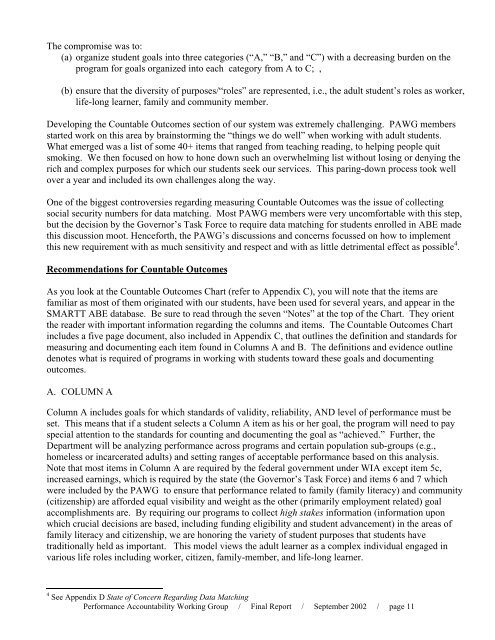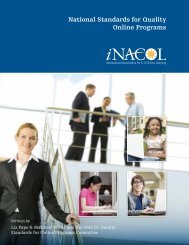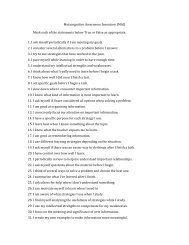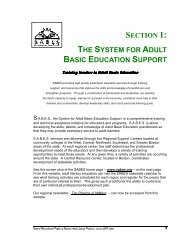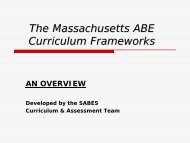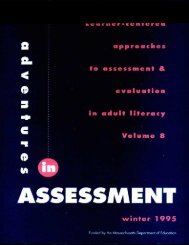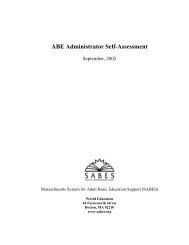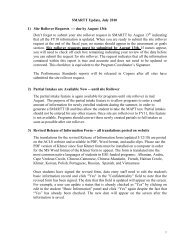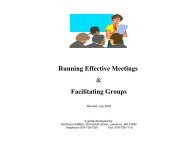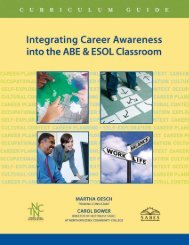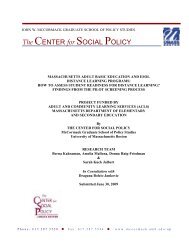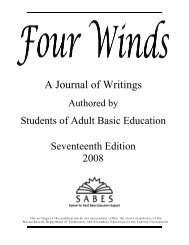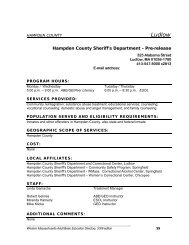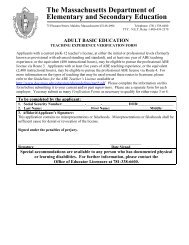PAWG I Final Report - SABES
PAWG I Final Report - SABES
PAWG I Final Report - SABES
Create successful ePaper yourself
Turn your PDF publications into a flip-book with our unique Google optimized e-Paper software.
The compromise was to:<br />
(a) organize student goals into three categories (“A,” “B,” and “C”) with a decreasing burden on the<br />
program for goals organized into each category from A to C; ,<br />
(b) ensure that the diversity of purposes/“roles” are represented, i.e., the adult student’s roles as worker,<br />
life-long learner, family and community member.<br />
Developing the Countable Outcomes section of our system was extremely challenging. <strong>PAWG</strong> members<br />
started work on this area by brainstorming the “things we do well” when working with adult students.<br />
What emerged was a list of some 40+ items that ranged from teaching reading, to helping people quit<br />
smoking. We then focused on how to hone down such an overwhelming list without losing or denying the<br />
rich and complex purposes for which our students seek our services. This paring-down process took well<br />
over a year and included its own challenges along the way.<br />
One of the biggest controversies regarding measuring Countable Outcomes was the issue of collecting<br />
social security numbers for data matching. Most <strong>PAWG</strong> members were very uncomfortable with this step,<br />
but the decision by the Governor’s Task Force to require data matching for students enrolled in ABE made<br />
this discussion moot. Henceforth, the <strong>PAWG</strong>’s discussions and concerns focussed on how to implement<br />
this new requirement with as much sensitivity and respect and with as little detrimental effect as possible 4 .<br />
Recommendations for Countable Outcomes<br />
As you look at the Countable Outcomes Chart (refer to Appendix C), you will note that the items are<br />
familiar as most of them originated with our students, have been used for several years, and appear in the<br />
SMARTT ABE database. Be sure to read through the seven “Notes” at the top of the Chart. They orient<br />
the reader with important information regarding the columns and items. The Countable Outcomes Chart<br />
includes a five page document, also included in Appendix C, that outlines the definition and standards for<br />
measuring and documenting each item found in Columns A and B. The definitions and evidence outline<br />
denotes what is required of programs in working with students toward these goals and documenting<br />
outcomes.<br />
A. COLUMN A<br />
Column A includes goals for which standards of validity, reliability, AND level of performance must be<br />
set. This means that if a student selects a Column A item as his or her goal, the program will need to pay<br />
special attention to the standards for counting and documenting the goal as “achieved.” Further, the<br />
Department will be analyzing performance across programs and certain population sub-groups (e.g.,<br />
homeless or incarcerated adults) and setting ranges of acceptable performance based on this analysis.<br />
Note that most items in Column A are required by the federal government under WIA except item 5c,<br />
increased earnings, which is required by the state (the Governor’s Task Force) and items 6 and 7 which<br />
were included by the <strong>PAWG</strong> to ensure that performance related to family (family literacy) and community<br />
(citizenship) are afforded equal visibility and weight as the other (primarily employment related) goal<br />
accomplishments are. By requiring our programs to collect high stakes information (information upon<br />
which crucial decisions are based, including funding eligibility and student advancement) in the areas of<br />
family literacy and citizenship, we are honoring the variety of student purposes that students have<br />
traditionally held as important. This model views the adult learner as a complex individual engaged in<br />
various life roles including worker, citizen, family-member, and life-long learner.<br />
4 See Appendix D State of Concern Regarding Data Matching<br />
Performance Accountability Working Group / <strong>Final</strong> <strong>Report</strong> / September 2002 / page 11


